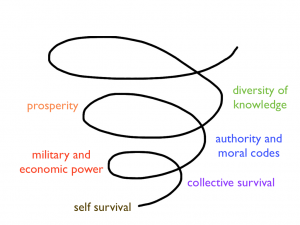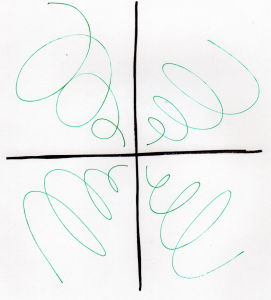Drawing on the work of Ken Wilber’s Integral Theory, Marilyn Hamilton gives us a very simple way of seeing a whole city.
Integral theory conjures four quadrants for life experience. The two axis in Brandy Agerbeck’s illustration (Figure 1) reflect our individual / collective experiences, and our interior/exterior experiences. The upper left quadrant is about how I show up inside myself – my inner well-being. The upper right quadrant is about how I show up on the outside – my behavior. The lower right is about how we show up collectively on the outside – our structures. The lower left is about how we collectively who up on the inside – our culture. Simply, what is going on inside – our inner weather – and what is going on outside – the structures (physical and otherwise) we create.
The understanding that integral theory offers can be used at any scale – an individual, family, neighbourhood, city, nation, species. Hamilton applies this framework to the city, revealing four voices:
- City Managers – elected officials, decision-makers, institutions
- City Builders [1] – those that physically build our cities – developers, builders, utilities, transportation, inspectors, municipal organizations, health authorities
- Citizens – the people who live in our communities
- Civic organizations – service organizations, not-for-profits, community organizations (chamber of commerce, sierra club, united way…)
At quick glance, it is easy to see how each of these voices have a hand in shaping the place we live – both the physical structure of it, as well as the social structure. What we don’t contemplate is how each of these roles has a legitimate role to play in our creation (and re-creation) of our communities and cities. For example, the city managers run our institutions – the very organizations that are charged with working for the public interest. Yet the city builders are the people and organizations that actually build the city we live in. They take the risk, they do the work, they reap the rewards and losses. Typically, these two facets of city creation are in conflict with each other.

In the end, these four quadrants can be quite separate from each other. They can be very firm in their ‘silos’, with very little interaction (ie only when necessary), let alone integration. And this can take place within each quadrant as well. It is easy to imagine citizens in conflict with city hall, or civic organizations in conflict with city hall. Or an environmental group and a developer in conflict. Conflict and opportunity is everywhere. How does this connect to the purpose of the city and our levels of organizing that emerged when asking the question, Is the unplanned city unplanned? Part 1, Part 2, Part 3 and Part 4. (See Part 3 and Part 4 for specifics on the Spiral diagram).

The purpose of the city (Figure 3) and the levels of organizing evolve within and between each of the four integral city voices (Figure 4). The purpose and levels of organizing do not necessarily advance equally, but the order of advancement is the same. City voices could, in fact, be in several places at once; it is not a uniform experience. The city managers could be looking for a high level of order while the city builders could be looking for a lesser degree of order. Civil society could be looking for a higher degree of order than citizens. As a whole, the city is a dance among voices and values.
The Integral City voices give us a way to look at the voices in the city – the perspectives. Each voice, as an individual and as a collective, will see the purpose of the city differently depending upon the life conditions experienced. How we see the purpose of the city, whether explicitly or implicitly, shapes how we organize ourselves as well. The city is a dance of voice and values, where we organize ourselves to thrive.
In my next post, I will explore how varied these voices and values can be.
[1] I have used the word ‘builder’ here instead of developer to ensure a distinction from the qualitative aspects of the word ‘development’ in Chapter 1 – The City Impulse.
Sources –
Beck, Don Edward and Cowan, Christopher C., Spiral Dynamics: Mastering Values, Leadership, and Change, Blackwell Publishing Ltd., Oxford (2006), particularly pages 52-56.
Hamilton, Marilyn, Integral City: Evolutionary Intelligences for the Human Hive, New Society Publishers Inc., Gabriola Island (2008)
Sanders, Beth, “From the High Water Mark to the Back of the Fish Flakes: The Evolutionary Purpose of Cities,” Vol 51, No. 4, p 26-31, Plan Canada. Print publication of the Canadian Institute of Planners.
Wilber, Ken, A Brief History of Everything, Shambhala Publications Inc., Boston (1996, 2000)